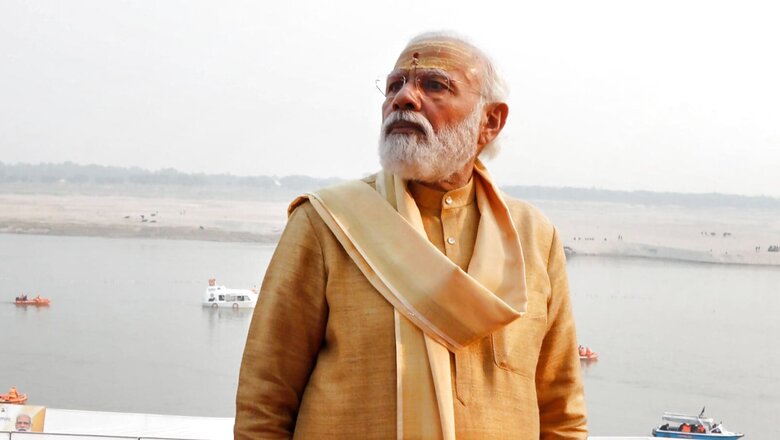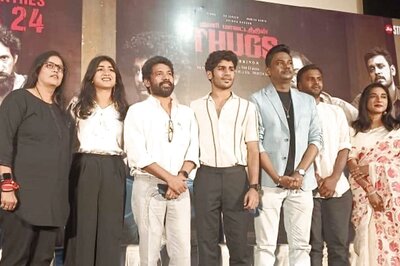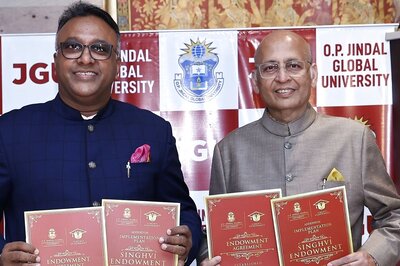
views
As 2021 draws to a close, the year-end retrospectives on India are aplenty. While there are several ways to look at the year, the one unmistakable imprint that India has left in the year 2021 is its ability to implement at a billion-plus scale. Even when a global pandemic was raging, India was able to deliver the world’s largest vaccination drive in as diverse—geographically and culturally—a country as India. As of December 30, 2021, India has administered a total of 1.44 billion COVID vaccine doses with over 70 per cent of the eligible population fully vaccinated.
But vaccination was not the only implementation that India was able to pull off. The year 2021 saw India undertake many path-breaking economic reforms—such as in FDI; delivery of cash and kind help to more than 800 million people; reviving the economy to become the fastest growing major economy in the world and becoming a Startup hub of the world with 42 unicorns emerging in this year alone.
So how is India able to master this Art of Implementation? The credit must go to Prime Minister Narendra Modi who has, since he assumed office in 2014, fine-tuned this world-class implementation machinery that now has become a part of the culture.
But how has Modi been able to turn around India’s image from being an acknowledged laggard in implementation to one which sets global standards?
There are 10 tools—or apps in modern lingo—that Modi has perfected in 20 years of governance—12.5 years as Chief Minister and 7.5 years as Prime Minister—that help him achieve the implementation miracle.
What are the 10 apps that help Modi in the Art of Implementation?
First, Jan Bhagidari or Participative Governance. Think of Janta Curfew before the announcement of first lockdown at the start of the pandemic. No mandate, no coercion and yet the entire country came together as one to observe a voluntary lockdown. This participative form of governance has been the hallmark of Modi since his Gujarat days. From Shala Pravesh to Kanya Kelavani and from Jal Shakti to Krishi Mahotsav. The same model has been in vogue at national scale since 2014. When the decisions of the government have been arrived at through consultation with the people then the same people also develop a stake in implementing those decisions. Simple enough concept? And yet, observe the transformative change it has brought about in India post 2014 and especially in 2021.
Second, The Other Side of the Table Mindset. An illustrative example of how this works is best understood from Modi’s early days as Chief Minister. Not one officer was able to complete the widow pension forms that they themselves had designed for availing the benefits of the scheme. That form was changed after Modi demonstrated the futility of not factoring in the views or the needs of those at the other side of the table. This lesson has since remained with Modi. Because the schemes are now designed not to exclude or only to make the official file perfect, but to facilitate the people to avail it without hassle, the implementation of the same scheme obviously improves at manifold scale.
Third, Consistency of Policy. Modi’s beliefs—ideological and in governance—are not transitory or electorally dependent but have a consistency about them which is life-long. Contrast Modi’s love for soldiers or his Temple visits to the transitory nature of some other high-profile politicians who also indulge in such activity as tactical ploys just before elections. Modi’s consistency gets transmitted to the people with the message that if he is talking about a policy or plan, it is a deeply held belief and not for his personal benefit but for the larger societal benefit and hence participation of implementation machinery is that much greater. It is such consistency that makes Swachh Bharat a mass movement and hence a success.
Fourth, ‘Can Do’ Spirit. Just as youth have this can-do spirit about any challenge they face, so has Modi. The enormity of the challenge does not daunt him, rather he revels in it. Bigger the challenge, bigger is his enthusiasm to face it. That energy is infectious and passes on. After all, who would not want their ambitions to be high, to match the best in the world? Think of Kashi Vishwanath Corridor. Or vaccinating India’s adult population against COVID-19. Or facilitating the construction of Temple at Shri Ram’s birthplace. Or reaching every household with electricity, LPG connection and tap water supply. Or banking for every person in the country. Or making India the world’s largest digital payments ecosystem. Each of them as daunting as the other. Yet, all done with the ‘can do’ spirit.
Fifth, Use of Technology. Corruption was an endemic problem in transferring government benefits. Taxation was a hassle for the honest taxpayer. Real-time tracking of vaccination would be an impossible task in a country of our size. All seemingly insurmountable problems for an India that was before 2014. Not anymore. All solved. Through use of technology that enables implementation of ambitious goals that have far-reaching outcomes.
Sixth, Feet on the Ground. An important facet of implementation is having a real-time feedback loop that can help fine-tune a policy based on insights that can only come from the ground. Such loop, even if it exists, will work only if the feet of policy makers are firmly on the ground. Think of the tweaks in Pradhan Mantri Fasal Bima Yojana. Or the constant calibration of policy in the immediate weeks after demonetisation. Or how the Jan Dhan account holders were encouraged to start transacting and which have now more than 1.5 lakh crore deposits. This experience of ‘feet on the ground’ approach also builds trust among the people for next round of policy work because they know the leadership listens in real-time and calibrates action in real-time.
Seventh, Rooted Civilizationally. For Modi’s critics this facet may confound them but one of the reasons for Modi’s success is his civilizational ethos. Modi celebrates India, without question or hesitation, thus sending the message that he celebrates every Indian as well.
Modi’s inspirational heroes, the quotes he uses, the anecdotes he gives, the stories he tells—are all Indian in nature, unlike previous Prime Ministers or most other politicians. Every day, he connects more and more with the people of India who are similar in ethos as him. Take the example of Democracy. Before Modi, even Indians had internalized that democracy is a Western construct. It is Modi who has brought our glorious traditions from Licchavi Republics in BC era to Uttaramerur Inscription from Tamil Nadu from 8th century to the work of Basavanna, all before the West even began to think in terms of any form of representative government. Because Modi celebrates India and all its achievements—from Startups to Sports and from Science to Medicine—the vast majority of Indians align with him to make us succeed even more.
Eighth, The Understanding of Economic Incentives. Before Modi, central governments, especially at the Prime Minister level, focused almost exclusively on macroeconomics. Fiscal policy, export-import, budget deficits, industrial policy etc. was all that they thought were good enough for their focus. Micro economics was beneath them. Modi has changed this dynamic.
Micro-economics is now as important a policy action front as the macro, for Modi realizes that both are interlinked and as a nation we cannot succeed without getting both right. The incentive structure that micro-level interventions build help in making Modi succeed in implementing the macro policy as well. Modi is the same man who is ensuring clean tap water supply to every home. Modi is the same man who is reforming FDI policy. The success of the former helps the latter succeed as well.
Ninth, ‘No More Second Best’ Mindset. With Modi at helm, and in just over seven years, the young generation of India is now not merely playing for participation certificate but wants a position at the podium.
In India of 2021, we would not have been satisfied with waiting for the world to give us vaccines at its own pace— as happened in the past and with decades of delay. India now wanted ‘Made in India’ vaccines at the same time as anyone in the world had it. And India succeeded with not just one but two such vaccines.
This mindset of wanting a place at the podium is backed up by delivery—from largest financial inclusion programme in the world to the biggest health insurance scheme in the world. A country which starts believing in its ability for a podium finish then also develops the wherewithal and the mindset to ensure that it happens.
Tenth, and the Most Important is Sabka Saath, Sabka Vikas. The fundamental way in which Modi is different from the ‘ancien regime’—and the Nehruvian consensus that drove it—is the motto of Sabka Saath, Sabka Vikas.
Earlier it was about delivering, if at all, for a particular segment, group, region or caste. There was even a government that believed in delivering for only minorities, especially the Muslim minority. Contrast this with Modi: 44 crore bank accounts, 144 crore vaccine doses, 32 crore Mudra loans, 9 crore Ujjwala cylinders, 5.5 crore tap water connections to households. Such numbers only happen when policy is all inclusive and not exclusive.
Modi’s basic branding is to deliver to ALL eligible and ask for the big number. Since it can only happen if ALL are covered, obviously it also motivates ALL to help in implementing that policy.
This fundamental mindset change—from delivering for groups and subgroups to delivering for ALL—is what constitutes the underlying base for Modi’s implementation skill. Subsequently Sabka Vishwas and Sabka Prayas have further emboldened the policy contrast with the Nehruvian idea that existed before 2014.
As India enters 2022, the 75th year of our Independence, it bodes well for us as a people that we now not only have the ambition to dream big but also the ability to achieve those dreams. When more than 1.4 billion people develop this combination—of ambition and implementation skill—they are poised to become a leading force in the community of nations.
Our journey is still not complete. India has lots more to achieve. And, the fortune to be led by Prime Minister Modi to achieve the feat. Year 2021 leaves us with a positive experience, despite the challenges, for a 2022 and beyond repeat.
The writer is CEO of Bluekraft Foundation. The views expressed in this article are those of the author and do not represent the stand of this publication.
Read all the Latest Opinions here




















Comments
0 comment